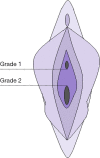Catheter-associated meatal pressure injuries (CAMPI) in patients with long-term urethral catheters-a cross-sectional study of 200 patients
- PMID: 38404556
- PMCID: PMC10891379
- DOI: 10.21037/tau-23-445
Catheter-associated meatal pressure injuries (CAMPI) in patients with long-term urethral catheters-a cross-sectional study of 200 patients
Abstract
Background: Indwelling urethral catheters (IDC) are ubiquitous to healthcare settings, and are associated with many familiar risks like haematuria, infections, bladder spasms and stones. However, a less known complication is catheter-associated meatal pressure injury (CAMPI), especially in those with long-term IDCs. The objective of this study was to explore the prevalence, associated features and management of CAMPI in adults with a long-term IDC.
Methods: A cross-sectional multi-centre study was undertaken of 200 adults with a long-term IDC across regional south-west Queensland, Australia between June 2019 to June 2021. The prevalence of CAMPI was determined by clinical examination, voluntary surveys completed by participants and documentation in medical records. Key IDC statistics included total duration of IDC, location of IDC changes, IDC size, type and fixation.
Results: Out of 200 adults with a long-term IDC, 9% (18/200) had a CAMPI. There was a higher prevalence of male CAMPI (17/169, 10%) compared to female CAMPI (1/31, 3%). The median time to identification of a CAMPI after initial IDC insertion was 12 weeks (2-136 weeks), but occurred as soon as 2 weeks. CAMPI formation was associated with IDC changes in the community, impaired mobility and congestive cardiac failure (CCF). CAMPI were mostly treated by conservative means given the frailty of the population.
Conclusions: Poor mobility, community-managed IDCs, and CCF were all found to have statistically significant associations with the development of CAMPI. CAMPI represents an important and underserved iatrogenic complication within urology practice, and greater awareness is needed to prevent it in vulnerable patients with long-term IDCs.
Keywords: Urology; community health services; complications; urinary catheter; urological surgical procedures.
2024 Translational Andrology and Urology. All rights reserved.
Conflict of interest statement
Conflicts of Interest: All authors have completed the ICMJE uniform disclosure form (available at https://tau.amegroups.com/article/view/10.21037/tau-23-445/coif). The authors have no conflicts of interest to declare.
Figures
References
-
- Lachance CC, Grobelna A. Management of Patients with Long-Term Indwelling Urinary Catheters: A Review of Guidelines. Ottawa (ON): Canadian Agency for Drugs and Technologies in Health; May 14, 2019. - PubMed
LinkOut - more resources
Full Text Sources
Medical



